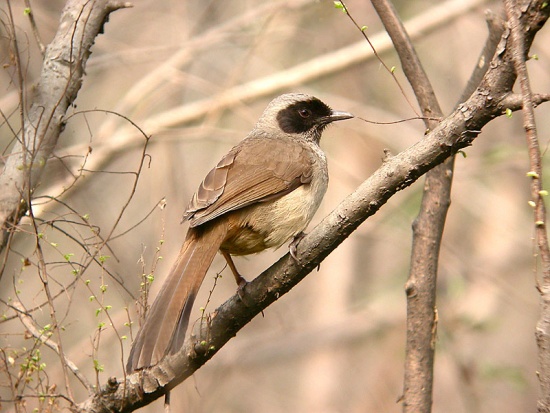
Alternative names: Black-faced Laughingthrush; Spectacled Laughingthrush; Masked Jay-thrush
- Garrulax perspicillatus
Identification
With 28 - 31.5 cm a large, striking Laughingthrush1:
- Dull plain grey-brown above
- Greyish-buff below
- Greyish-head
- Large blackish mask
Sexes are similar. Juveniles have a fainter mask.
Distribution
E and SE China (including Hong Kong) and N Vietnam.
Common in most of its range.1
Taxonomy
Monotypic. Sometimes placed in the new genus Dryonastes.1, 2
Habitat
Found in scrub, woodland, cultivated areas, often near villages, in thickets, bamboo, reeds and hedgerows. In Hong Kong in built-up urban areas, parks, villages and farmland. Generally in lowlands up to 1000m.1
Behaviour
Feeds on invertebrates, including grasshoppers, grubs and snails. Takes also seeds and fruit. Found in groups, often families of 6 - 12 birds. Skulking but also noisy. Forages usually on ground.
Breeding season from March to August, possibly a co-operative breeder. The nest is placed in a hedge or bush, also in bamboo, reed or grass, 1 - 9 m above ground. It's an untidy cup made of sticks, weed, grass, bamboo, leaves, sometimes paper and poultry feather. Lays 2 - 5 eggs.
Resident species.1
References
- del Hoyo, J., Elliott, A. and Christie, D.A. eds. 2007. Handbook of the Birds of the World. Vol. 12. Picathartes to Tits and Chickadees. Barcelona: Lynx Edicions. ISBN 84-96553-42-6
- Clements James F. 2007. The Clements Checklist of Birds of the World. 6th ed., with updates to October 2007. Ithaca: Cornell University Press. ISBN 9780801445019



